
Beijing Confucian Temple and the Imperial College is located at Guozijian street of Dongcheng District .It was built in Yuan Dynasty of 14century, with a long history of more then 700 years The Two groups of buildings constitute" temple on the Left and College on the right" regulation. Confucian Temple and the Imperial College unfold a picture scroll for its long history,unique architectural style,and profound chltyral connotation.
Beijing Confucius Temple
Beijing Confucius Temple was built in the 6th year of emperor of the Yuan Dade decade (1306), It was the place where memorial ceremonies were held for Confucius during the Yuan, Ming and Qing Dynasties Confucius Temple covers an area of over 22,000 square meters and construction area of 7400 square meters, three courtyards. Along the central south to north axis lie the teacher Gate, Dacheng Gate, Dacheng Hall, Chong Sheng Temple. There are 198 stone table, which are divided into 4 groups, positioned on either side of the front courtyard. Total 51,624 names, birthplaces and ranks of Jinshi were carved in the stone tablets. They are precious materials for research on the Chinese imperial examination .At present, there are three exhibitions in the Confucian Temple, including "Exhibition of the Restored Dacheng Hall" "Exhibition of the Geat Confucius" "Exhibition of the History of Beijing Confucius Temple
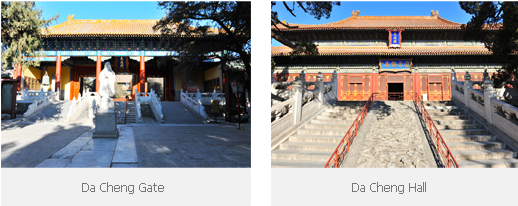
Guozijian
Guozijian in Beijing was the highest educational institution and administering organ of education set up by the state during the three dynasties of Yuan, Ming and Qing. Built in the first year of the Zhida reign in the Yuan Dynasty(1308), Guozijian covers an area of 28,000 square meters with three courtyards. On the central axes, there are jixian Gate, Taixue(Imperial College)Gate, Glazed memorial Arch, Biyong Hall, Yilun Hall and Jingyi Hall.There are two halls and six main romms, Imperial tablet Pavilion, Bell and Drum Pavilion lined traditionally and symmetrically beside the central axes.AT present, there are three exhibitions in Guozijian, including "Exhibition of the Restored Biyong Hall""Exhibition of the Restored Guozijian""Exhibition of the Chinese Imperial Examination".
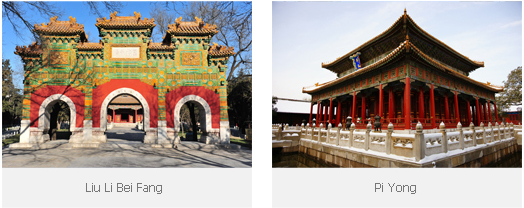

At present,there are six permanent exhibition in the Confucian Temple and Guozijian museum, including "Exhibition of the Restored Dacheng Hall" "Exhibition of the Geat Confucius" "Exhibition of the History of Beijing Confucius Temple"and "Exhibition of the Restored Biyong Hall""Exhibition of the Restored Guozijian""Exhibition of the Chinese Imperial Examination".
Exhibition of the Chinese Imperial Examination
Getting high and good marks in the examination is the happiest time for the students and their parents. In ancient China, the paper that wrote the results of the students was called "jinbang" (jin means gold in Chinese). The imperial examination system was the old examination system in feudal China. Those who excelled would bring prestige and honour to their families and clansmen. The imperial examination system was the typical Chinese educational system and official selecting system. This exhibition will show you the history, procedure and influences of it.
The imperial examination system was set up in Han Dynasty, it was developed quickly in Sui and Tang Dynasty, and fully developed in Qing Dynasty. It had lasted for 1300 years in China, in that periods, a lot of knowledgeable intellectuals became the officials and staffs in governments. It had helped Chinese society developed.
In Tang Dynasty, empress wuzetian developed the imperial examination, she added the martial exam. From then on, the imperial examination system was finally set up. The literature exam was used for selecting civil service official. And the martial exam was used for selecting martial service official. In Song Dynasty, the imperial examination system was improved, the whole procedure of the examination was settled down as: the exam would be held every three years, and there would be three main exams which was "xiangshi"( exams in the county), "huishi" ( major exams) and "dianshi" (the emperor would select the best students in the palace).
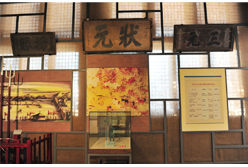
The whole procedure of the imperial examination was complex and strict. The exam would be held every three years, and there would be three main exams which was "xiangshi"( exams in the county), "huishi" ( major exams) and "dianshi" (the emperor would select the best students in the palace). From Ming Dynasty, all of the students attended the imperial examination had to studied in the governmental schools.
When the students entered the governmental school, they would attend the "xiangshi" (exams in the county). The student got the first place was called "xieyuan" and other selected students were called "juren". Then, the winners would attend the "huishi" ( major exams) and "dianshi" (the emperor would select the best students in the palace). The first three students in the imperial examination was called "zhuangyuan"( the first place), "bangyan" ( the second place) and "tanhua" ( the third place).
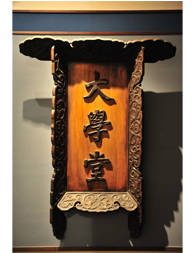
"dianshi" (the emperor would select the best students in the palace) was the highest ranked examination. It would be held in the baohe palace inside the forbidden city. The test questions were raised by the emperor personally. In the end, the emperor would read the papers of the top ten students and judge the first, second and third place. In late Qing Dynasty, the students attended the "dianshi" would enter the palace about 5 or 6 a'clcok in the early morning. They had to finish their paper before the sunset, in the noon they could drink some tea and eat some snacks.
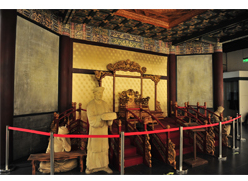
The paper that wrote the results of the students was called "jinbang" (jin means gold in Chinese).there would be two pieces of result paper, one would be stored in the file house, the other would be hanged on the wall of forbidden city in the eastern changan street for people to read.
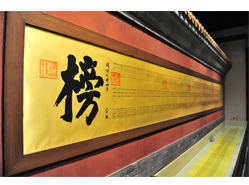
The imperial examination system was the symbol of equality in the feudal society in China, we should gain the essential part of it.
Exhibition of the Geat Confucius
The Confucius was named: "kongzi" in Chinese. He was born in "lu" country and lived his life in late spring and autumn period. The Confucius was a great thinker, educationalist and he was the founder of Confucianism. His thoughts had great influences on all the Chinese people even people in other nation, and the prime of his thoughts still useful in today's society. Now let's go and experience his life.
The Confucius used to say that: " I made up my mind to learn when I was 15." In his period, the whole society was in chaos, the Confucius began to think that in what way he could change the chaos of the whole society. He thought about the harmonious ancient period when the great emperors yao and shun ruled the country. The Confucius decided to devote himself changing the society into a harmonious one by learning knowledge. He learned knowledge by himself and from different people, he thought every people could be his teacher.
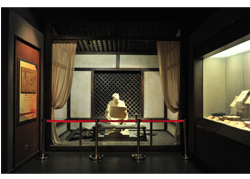
When The Confucius was 30 years old, he began to set up private school for normal people. He thought learning was the most important way for people, it was easy for educational people to reach the high moral standard. The Confucius thought everyone had right to receive education, he firstly put such equal idea of receiving education in Chinese history. Here you may an ancient Chinese calculator named "suan chou" which had a history of 1800 years. This calculator used wooden sticks to put numbers from 1 to 9 in two ways: one is horizontal the other is vertical in formula.
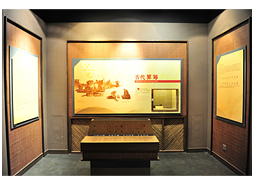
The political ideas of Confucius were to rule the country with morality. In his view, if the emperor ruled the country with morality he would be like the polaris with different stars surrounded. His ideal society was the "datong" society which means all the people lived in harmony and the officials should help the emperor to rule the country both in the moral way and under the rule of law. The imperial examination system was coming from his official selecting system.
To build the harmonious society is the one of the main idea of the Confucius which is about the relationship of human being and nature, man between man and one single man. He thought if the human being could live harmoniously with nature, they would have their own living space. He raised the idea of keeping the balance of the nature.

The student's of the Confucius had set up 8 branch thought from the Confucianism. Among them, thinker Mengzi had done great contribution on the development of the Confucianism.
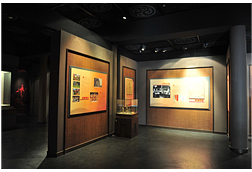
The Confucianism had spread into the Chinese minorities living in western northern China and western southern China. In 17th century, the figure of the Confucius had appeared on the drawings in Tibet. Moreover, the Confucianism had spread into other countries in Asia such as Korean peninsula, Vietnam, Japan. In these countries.
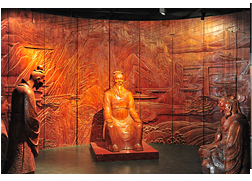
The thoughts of the Confucius are the great treasure of Chinese people. In 2000, the Confucius institute was set up in people's university of China. And what's more, some nongovernmental organizations about the Confucius have been set up. And stories and ideas of the Confucius have been the courses for children in China. There are about 200 institute about the Confucius all over the world now, more and more friends from different countries have known about this great thinker in China.

The collections of the Confucian Temple and Guo Zi Jian(Imperial College) were divided into six,such as stone, bronze, porcelain, jade, wood and embroidery, and most of them were the relics of the Emperor Kangxi, Yongzheng and Qianlong reign of the Qing dynasty.
Sacriticial vessels, utensils and musical instruments, used in sacrifical ceremony and daily worship, were mostly made in the reigns of Kangxi,Yongzheng and Qianlong during the Qing Dynasty. The vessels include zun, jue, you, bian and dou, and the instruments include set bells, set stone chimes, chu, and chi, which are rarely seen in modern instrumental performance.
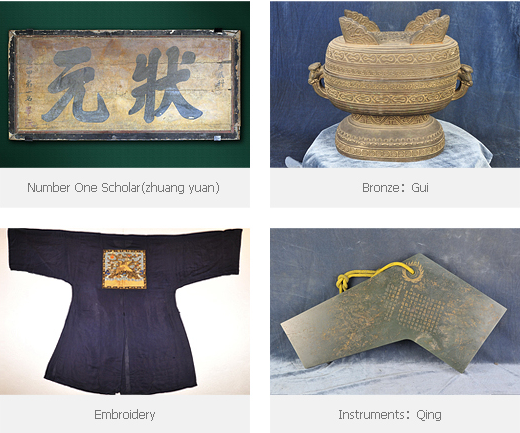

An Introduction to "Dacheng Rites-music" of Confucian Temple
Rites-musical culture is an educating system formulated by combining ritual education and musical education together, the literal meaning of which is educating people with rites and music. Ever since Confucius, the Confucian School has attached great importance to rites-music. The Imperial College of Confucius Temple is the place where officials of Yuan,Ming and Qing Dynasties practiced rites and preached enlightenment. In the Chong-Sheng Memorial Hall of Confucian Temple, an exhibition named performance of dacheng rites-music is on display, which enriches traditional exhibition of the museum. This innovation brings new sensation to audiences both visually and aurally and they can feel the profoundness and extensiveness of the traditional rites-musical culture in the interaction with the actors.
Taken the traditional rites and music as materials, Dacheng rites-music went through a series of refinement and adaptation. Now it becomes a performance of the integration of music, dance and recitation, which is worthy of watching. Based on the Confucius's aesthetic thought on rite and music, the performance endows the content of rites with the form of music ,which pursues rites with music and carries morality with music ,thus educating people with morality. From the perspective of aesthetics of music, dance and vocal music, it presents the audiences an interesting performance they can easily understand. The performance helps the audience feel the solemnity, dignity, elegance, implicitness, harmony and purity of rites-music, the quintessence of traditional Chinese culture and the age spirit of Confucian Thought. What's more, it intends to enlighten people and convey the artistic purpose of cultivating people with rites and moving people with music.
An introduction to the performance
1. Prologue:
Friends----The shocking sound of the drums and bells and the melodious ancient music echo in the solemn and dignified palace of Imperial College of Confucian Temple. The solemn door of Chong-Sheng Palace opens slowly. The stentorian and dignified recitation conveys the profoundness and extensiveness of Confucian Culture, making everyone feels at home.
2. Scene One:
Learning-----The dancer, with bamboo slips in his hand and head upward, devoutly recites Analects of Confucius on the gentle music. It seems to bring us back to the times of Confucius, a society with rigorous and meticulous learning atmosphere, from which we can feel the spiritual core of Confucian culture.
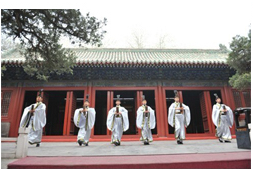
3. Scene Two:
Happiness------- A group of beautiful girls move their steps elegantly, their long sleeves and garment floating in the air. They graciously performed the imperial dance of Han Dynasty, dignified yet elegant, solemn yet gaily.
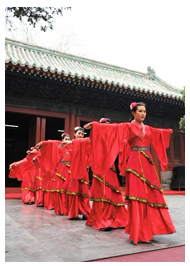
4. Scene Three:
Guanju--------Guanju, the first poem in the Book of Poetry, is a poem depicting a young man arduously pursues a beautiful and kind girl. Against the aesthetic, elegant and magnificent music, the performance integrates the implicitness, tenderness and elegance of classic dance with the rich voice of the baritone by means of modern design techniques. It presents the aesthetic value and idea contained in the poem to the audience and incorporates them into the national spirit and culture so that they can be handed from generation to generation.
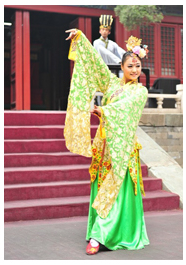
5. Scene Four:
Harmony------The dances performed the Bayi dance (a dance consisted of 64 people) to commemorate Confucius in an orderly way in the serene, solemn and dignified music. The recitation of harmony from the Book of Rites brings us back to the society where people live in harmony with each other, manifesting that the ancient people yearn for harmony. It intends to make people have an understanding of the social, historical and cultural background of the harmonious ideology and harmonious society of the ancient people, which will have a positive influence on the construction of modern harmonious society.
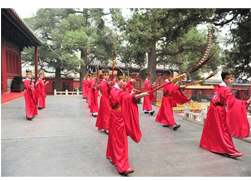

Open Time:
8:30—17:00 (throughout the year)
Route by Public Transport:
Metro line, fifth line Lama Temple and get off: bus 116,684,13,117 Road Lama Temple Station, 113,108,104,803,124,758,850 Fang alley to get off.
Address:
NO.13-15 Guozijian Avenue, Dongcheng District, Beijing
Inquire Telephone :
84027224 84011977
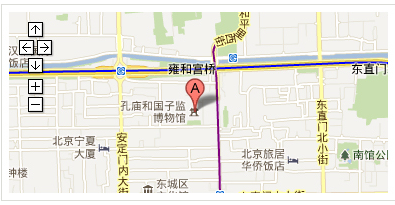
Ticket Information:
Ticket Price:
¥30/person (full-price ticket); ¥15/person (half-price ticket)
Free of charge for Middle and primary school students, half-price ticket for college students.
Free of Charge: retired cadres with relevant identity cards
Free of charge for rankers against valid certificates.
Free of Charge: children under 1.2 m
Free of charge for the disabled against valid certificates.
Information Centre:
Free Commentator Service
Language: Chinese English
Free of charge at 10:00am, 2:00pm (Chinese);
non-gratuitous in other time
Audio Guide Rental Service
Language: Chinese English Japanese Korean French
Rent: ¥200 & valid ID credentials/ Audio Guide
Price: Chinese ¥20/ Audio Guide English Japanese Korean French¥30/ Audio Guide
Commentator Service
Language: Chinese English Japanese
Price: Chinese-100RMB, English-200RMB(Less than one hour)
Other Service Available (free of charge)
Wheel chair, Baby carriage, Umbrella, Luggage deposit
Deposit: 1000yuan RMB & valid ID credentials /a wheel chair or baby carriage,100yuan RMB/an umbrella

.png)